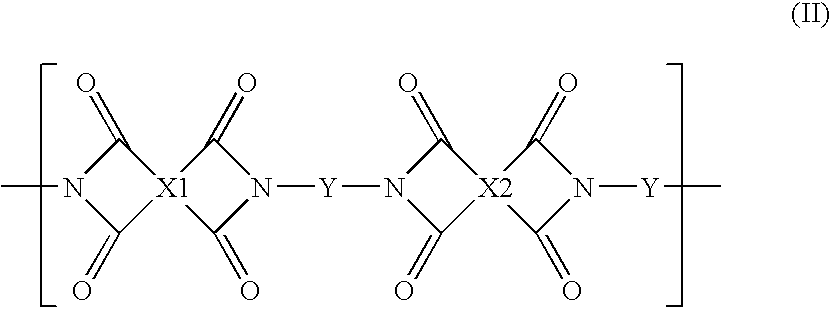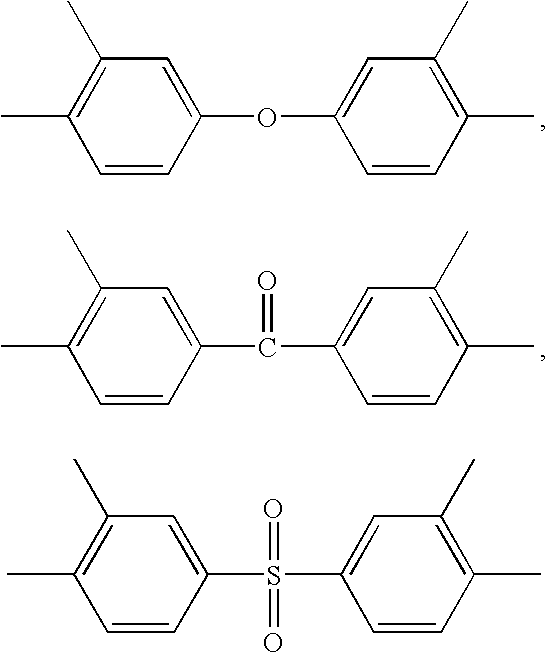High performance cross-linked polybenzoxazole and polybenzothiazole polymer membranes
a polymer membrane, high-performance technology, applied in the direction of inorganic chemistry, alkali metal oxides/hydroxides, chemical/physical processes, etc., can solve the problems of insufficient thermal stability and contaminant resistance of traditional polymer membranes, and inability to meet the requirements of high-performance polymer membranes. , to achieve the effect of improving membrane selectivity and chemical and thermal stability, high selectivity ratio ratio
- Summary
- Abstract
- Description
- Claims
- Application Information
AI Technical Summary
Benefits of technology
Problems solved by technology
Method used
Image
Examples
example 1
Synthesis of poly(BTDA-APAF) polyimide
[0061]An aromatic poly[3,3′,4,4′-benzophenonetetracarboxylic dianhydride-2,2-bis(3-amino-4-hydroxyphenyl)-hexafluoropropane] (poly(BTDA-APAF)) polyimide containing UV cross-linkable carbonyl groups and pendent —OH functional groups ortho to the heterocyclic imide nitrogen in the polymer backbone was synthesized from 2,2-bis(3-amino-4-hydroxyphenyl)-hexafluoropropane diamine (BTDA) and 3,3′,4,4′-benzophenonetetracarboxylic dianhydride (APAF) in NMP polar solvent by a two-step process involving the formation of the poly(amic acid) followed by a solution imidization process. Acetic anhydride was used as the dehydrating agent and pyridine was used as the imidization catalyst for the solution imidization reaction. For example, a 250 mL three-neck round-bottom flask equipped with a nitrogen inlet and a mechanical stirrer was charged with 10.0 g (27.3 mmol) of APAF and 40 mL of NMP. Once the APAF was fully dissolved, a solution of BTDA (8.8 g, 27.3 mmo...
example 2
Synthesis of poly(ODPA-APAF) polyimide
[0062]The aromatic poly[4,4′-oxydiphthalic anhydride-2,2-bis(3-amino-4-hydroxyphenyl)-hexafluoropropane] (poly(ODPA-APAF)) polyimide containing pendent —OH functional groups ortho to the heterocyclic imide nitrogen in the polymer backbone was synthesized from 4,4′-oxydiphthalic anhydride (ODPA) and 2,2-bis(3-amino-4-hydroxyphenyl)-hexafluoropropane (APAF) in NMP polar solvent by a two-step process involving the formation of the poly(amic acid) followed by a solution imidization process. Acetic anhydride was used as the dehydrating agent and pyridine was used as the imidization catalyst for the solution imidization reaction. For example, a 250 mL three-neck round-bottom flask equipped with a nitrogen inlet and a mechanical stirrer was charged with 10.0 g (27.3 mmol) of APAF and 20 mL of NMP. Once APAF was fully dissolved, a solution of ODPA (8.88 g, 27.3 mmol) in 35 mL of NMP was added to the APAF solution in the flask. The reaction mixture was m...
example 3
Preparation of poly(BTDA-APAF) polymer membrane
[0063]The poly(BTDA-APAF) polymer membrane was prepared as follows: 4.0 g of poly(BTDA-APAF) polyimide synthesized in Example 1 was dissolved in a solvent mixture of 12.0 g of NMP and 12.0 g of 1,3-dioxolane. The mixture was mechanically stirred for 2 h to form a homogeneous casting dope. The resulting homogeneous casting dope was allowed to degas overnight. The poly(BTDA-APAF) polymer membrane was prepared from the bubble free casting dope on a clean glass plate using a doctor knife with a 20-mil gap. The membrane together with the glass plate was then put into a vacuum oven. The solvents were removed by slowly increasing the vacuum and the temperature of the vacuum oven. Finally, the membrane was dried at 200° C. under vacuum for at least 48 hours to completely remove the residual solvents to form poly(BTDA-APAF) polymer membrane.
PUM
| Property | Measurement | Unit |
|---|---|---|
| temperature | aaaaa | aaaaa |
| temperature | aaaaa | aaaaa |
| time | aaaaa | aaaaa |
Abstract
Description
Claims
Application Information
 Login to View More
Login to View More - R&D
- Intellectual Property
- Life Sciences
- Materials
- Tech Scout
- Unparalleled Data Quality
- Higher Quality Content
- 60% Fewer Hallucinations
Browse by: Latest US Patents, China's latest patents, Technical Efficacy Thesaurus, Application Domain, Technology Topic, Popular Technical Reports.
© 2025 PatSnap. All rights reserved.Legal|Privacy policy|Modern Slavery Act Transparency Statement|Sitemap|About US| Contact US: help@patsnap.com



